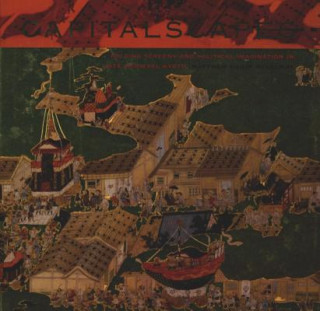
Kód: 11544869
Capitalscapes: Folding Screens and Political Imagination in Late Medieval Kyoto
Autor Matthew Philip McKelway
Following the destruction of Kyoto during the civil wars of the late fifteenth century, large-scale panoramic paintings of the city began to emerge. These enormous and intricately detailed depictions of the ancient imperial capita ... celý popis
- Jazyk:
 Angličtina
Angličtina - Vazba: Pevná
- Počet stran: 280
Nakladatelství: Univ of Hawaii Pr, 2006
- Více informací o knize

1990 Kč
Dostupnost:
50 % šance Máme informaci, že by titul mohl být dostupný. Na základě vaší objednávky se ho pokusíme do 6 týdnů zajistit.
Máme informaci, že by titul mohl být dostupný. Na základě vaší objednávky se ho pokusíme do 6 týdnů zajistit.Prohledáme celý svět
Mohlo by se vám také líbit
-

Oxford Edition of Blackstone's: Commentaries on the Laws of England
436 Kč -

Day by Day Armageddon
411 Kč -

Great Harry
657 Kč -

Essential Technique - Trombone Intermediate to Advanced Studies (Book 3 Level)
265 Kč -

Thebes in Egypt: Power, Restraint, and Privileges of Immunity in Early Medieval Europe
4288 Kč -

Black Rage in New Orleans: Police Brutality and African American Activism from World War II to Hurricane Katrina
1568 Kč -

Felix Furst Zu Schwarzenberg
1830 Kč
Darujte tuto knihu ještě dnes
- Objednejte knihu a zvolte Zaslat jako dárek.
- Obratem obdržíte darovací poukaz na knihu, který můžete ihned předat obdarovanému.
- Knihu zašleme na adresu obdarovaného, o nic se nestaráte.
Informovat o naskladnění knihy
Zadejte do formuláře e-mailovou adresu a jakmile knihu naskladníme, zašleme vám o tom zprávu. Pohlídáme vše za vás.
Více informací o knize Capitalscapes: Folding Screens and Political Imagination in Late Medieval Kyoto
Nákupem získáte 199 bodů
 Anotace knihy
Anotace knihy
Following the destruction of Kyoto during the civil wars of the late fifteenth century, large-scale panoramic paintings of the city began to emerge. These enormous and intricately detailed depictions of the ancient imperial capital were unprecedented in the history of Japanese painting and remain unmatched as representations of urban life in any artistic tradition. Capitalscapes, the first book-length study of the Kyoto screens, examines their inception in the sixteenth to early seventeenth centuries, focusing on the political motivations that sparked their creation. Close readings of the Kyoto screens reveal that they were initially commissioned by or for members of the Ashikaga shogunate and that urban panoramas reflecting the interests of both prevailing and moribund political elites were created to underscore the legitimacy of the newly ascendant Tokugawa regime. Matthew McKelway's analysis of the screens exposes their creators' masterful exploitation of ostensibly accurate depictions to convey politically biased images of Japan's capital. His overarching methodology combines a historical approach, which considers the paintings in light of contemporary reports (diaries, chronicles, ritual accounts), with a thematic one, isolating individual motifs, deciphering their visual language, and comparing them with depictions in other works. McKelway's combined approach allows him to argue that the Kyoto screens were conceived and perpetuated as a painting genre that conveyed specific political meanings to viewers even as it provided textured details of city life. Students and scholars of Japanese art will find this lavishly illustrated work especially valuable for its insights into thecityscape painting genre, while those interested in urban and political history will appreciate its bold exploration of Kyoto's past and the city's late-medieval martial elite.
 Parametry knihy
Parametry knihy
1990 Kč
- Plný název: Capitalscapes: Folding Screens and Political Imagination in Late Medieval Kyoto
- Autor: Matthew Philip McKelway
- Jazyk:
 Angličtina
Angličtina - Vazba: Pevná
- Počet stran: 280
- EAN: 9780824829001
- ISBN: 082482900X
- ID: 11544869
- Nakladatelství: Univ of Hawaii Pr
- Hmotnost: 1197 g
- Rozměry: 237 × 235 × 25 mm
- Datum vydání: March 2006
Oblíbené z jiného soudku
-

Dune
217 Kč -

Haunting Adeline
620 Kč -

Berserk Deluxe Volume 2
1092 Kč -

White Nights
90 Kč -

Powerless
252 Kč -

Atomic Habits
490 Kč -

Dune Messiah
228 Kč -

Berserk Deluxe Volume 3
1142 Kč -

One Day
218 Kč -

Berserk Deluxe Volume 1
1115 Kč -

Iron Flame
354 Kč -

Surrounded by Idiots
303 Kč -

Harry Potter and the Prisoner of Azkaban (Minalima Edition)
993 Kč -

Gravity Falls Journal 3
440 Kč -

Heaven Official's Blessing: Tian Guan Ci Fu (Novel) Vol. 1
440 Kč -

The Creative Act
550 Kč -

Dune
204 Kč -

Hunting Adeline
642 Kč -

A Little Life
267 Kč -

Children of Dune
230 Kč -

Heaven Official's Blessing: Tian Guan Ci Fu (Novel) Vol. 2
479 Kč -

Bungo Stray Dogs, Vol. 8 (light novel)
404 Kč -

Percy Jackson and the Olympians 5 Book Paperback Boxed Set
953 Kč -

Solo Leveling, Vol. 1
443 Kč -

The Prisoner's Throne
251 Kč -

Court of Thorns and Roses
250 Kč -

Cry Baby Coloring Book
281 Kč -

Fourth Wing
353 Kč -

Icebreaker
199 Kč -

Berserk Deluxe Volume 6
1089 Kč -

Avatar, the Last Airbender: The Kyoshi Novels (Box Set)
833 Kč -

The 48 Laws of Power
601 Kč -

House of Leaves
462 Kč -

Twisted Lies
213 Kč -

Dune Messiah
277 Kč -

No Longer Human
339 Kč -

48 Laws Of Power
517 Kč -

Twisted Games
251 Kč -

Caraval Paperback Boxed Set
905 Kč -

Solo Leveling, Vol. 2
351 Kč -

Open Circuits
910 Kč -

Berserk Deluxe Volume 5
1119 Kč -

Heaven Official's Blessing: Tian Guan Ci Fu (Novel) Vol. 3
400 Kč -

Berserk Deluxe Volume 4
1292 Kč -

Court of Mist and Fury
250 Kč -

SOLO LEVELING V08
436 Kč -

English File Upper Intermediate Multipack A (4th)
487 Kč -

CHAINSAW MAN V14
253 Kč -

Before the Coffee Gets Cold
251 Kč
Osobní odběr Praha, Brno a 12903 dalších
Copyright ©2008-24 nejlevnejsi-knihy.cz Všechna práva vyhrazenaSoukromíCookies


 Vrácení do měsíce
Vrácení do měsíce 571 999 099 (8-15.30h)
571 999 099 (8-15.30h)